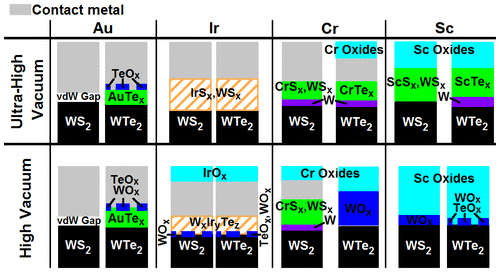当前位置:
X-MOL 学术
›
J. Phys. Chem. C
›
论文详情
Our official English website, www.x-mol.net, welcomes your
feedback! (Note: you will need to create a separate account there.)
Origins of Fermi Level Pinning between Tungsten Dichalcogenides (WS2, WTe2) and Bulk Metal Contacts: Interface Chemistry and Band Alignment
The Journal of Physical Chemistry C ( IF 3.3 ) Pub Date : 2020-06-11 , DOI: 10.1021/acs.jpcc.0c01646 Christopher M. Smyth 1 , Rafik Addou 1, 2 , Christopher L. Hinkle 1, 3 , Robert M. Wallace 1
The Journal of Physical Chemistry C ( IF 3.3 ) Pub Date : 2020-06-11 , DOI: 10.1021/acs.jpcc.0c01646 Christopher M. Smyth 1 , Rafik Addou 1, 2 , Christopher L. Hinkle 1, 3 , Robert M. Wallace 1
Affiliation

|
Thin metal films (Au, Ir, Cr, and Sc), deposited by an electron beam on bulk, exfoliated WS2 and WTe2 using two different reactor base pressures (high vacuum (HV) <2 × 10–6 mbar; ultrahigh vacuum (UHV) <2 × 10–9 mbar), are explored to study the effects of reactor ambient on the interface chemistry formed at room temperature between bulk metal contacts and tungsten dichalcogenides (TDCs). Au forms a van der Waals interface with WS2 and a covalent interface with WTe2, independent of reactor ambient. In contrast, an intermetallic is detected at the Ir–WS2 and Ir–WTe2 interfaces regardless of the reactor ambient. The low work function metals Cr and Sc, which are more reactive than their high work function counterparts (Au and Ir), completely reduce the TDC layer(s) in direct contact. Sc is completely oxidized in situ when deposited in an elastomer-sealed deposition tool (in HV). These results highlight that the interface between metals and TDCs is most often covalent, which contrasts the common misconception that a van der Waals gap is present. Furthermore, the band alignment between the four metals investigated here and bulk WS2 deviates significantly from that predicted by the Schottky–Mott rule. These results elucidate the true chemistry of select metal–TDC interfaces and highlight the rapid oxidation that manifests in situ in a HV metallization environment. Our work emphasizes the need to consider the true interface chemistry when engineering and modeling metal contacts to WS2 and WTe2.
中文翻译:

二硫化钨(WS 2,WTe 2)和块状金属触点之间的费米能级钉扎的起源:界面化学和能带排列
电子束使用两个不同的反应堆基本压力(高真空(HV)<2×10 –6 mbar;超高真空),通过电子束将金属薄膜(Au,Ir,Cr和Sc)沉积在剥落的WS 2和WTe 2上(UHV)<2×10 –9 mbar),用于研究反应器环境对室温下大块金属触点和二卤化钨(TDC)之间形成的界面化学的影响。Au与WS 2形成范德华界面,与WTe 2形成共价界面,而与反应器环境无关。相反,在Ir–WS 2和Ir–WTe 2处检测到金属间化合物界面与反应堆环境无关。与高功函数对应物(Au和Ir)相比,低功函数金属Cr和Sc具有更高的反应活性,可以完全减少直接接触的TDC层。当在弹性体密封的沉积工具中(HV中)沉积时,Sc被原位完全氧化。这些结果表明,金属与TDC之间的界面通常是共价的,这与常见的误解形成了范德华间隙的存在。此外,这里研究的四种金属与大块WS 2之间的能带对准与肖特基-莫特法则所预测的明显不同。这些结果阐明了选定金属-TDC界面的真实化学性质,并突出了在原位表现出的快速氧化在高压金属化环境中。我们的工作强调在对WS 2和WTe 2的金属触点进行工程设计和建模时,需要考虑真正的界面化学。
更新日期:2020-07-09
中文翻译:

二硫化钨(WS 2,WTe 2)和块状金属触点之间的费米能级钉扎的起源:界面化学和能带排列
电子束使用两个不同的反应堆基本压力(高真空(HV)<2×10 –6 mbar;超高真空),通过电子束将金属薄膜(Au,Ir,Cr和Sc)沉积在剥落的WS 2和WTe 2上(UHV)<2×10 –9 mbar),用于研究反应器环境对室温下大块金属触点和二卤化钨(TDC)之间形成的界面化学的影响。Au与WS 2形成范德华界面,与WTe 2形成共价界面,而与反应器环境无关。相反,在Ir–WS 2和Ir–WTe 2处检测到金属间化合物界面与反应堆环境无关。与高功函数对应物(Au和Ir)相比,低功函数金属Cr和Sc具有更高的反应活性,可以完全减少直接接触的TDC层。当在弹性体密封的沉积工具中(HV中)沉积时,Sc被原位完全氧化。这些结果表明,金属与TDC之间的界面通常是共价的,这与常见的误解形成了范德华间隙的存在。此外,这里研究的四种金属与大块WS 2之间的能带对准与肖特基-莫特法则所预测的明显不同。这些结果阐明了选定金属-TDC界面的真实化学性质,并突出了在原位表现出的快速氧化在高压金属化环境中。我们的工作强调在对WS 2和WTe 2的金属触点进行工程设计和建模时,需要考虑真正的界面化学。











































 京公网安备 11010802027423号
京公网安备 11010802027423号